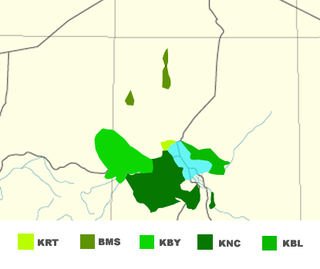
Kanuri is a Saharan dialect continuum of the Nilo–Saharan language family spoken by the Kanuri and Kanembu peoples in Nigeria, Niger, Chad and Cameroon, as well as by a diaspora community residing in Sudan.

Qashqai is an Oghuz Turkic language spoken by the Qashqai people, an ethnic group living mainly in the Fars Province of Southern Iran. Encyclopædia Iranica regards Qashqai as an independent third group of dialects within the Southwestern Turkic language group. It is known to speakers as Turki. Estimates of the number of Qashqai speakers vary. Ethnologue gave a figure of 1.0 million in 2021.
Naba is a Nilo-Saharan language spoken by approximately 500,000 people in Chad. Those who speak this language are called Lisi, a collective name for three closely associated ethnic groups, the Bilala, the Kuka and the Medogo, that represent the three dialects in which Naba is subdivided. They live mainly in the Batha Prefecture, but the Kuka are also in Chari-Baguirmi. Ethnologue estimates the lexical similarity among the three dialects to be no less than 99%. Arabic is often spoken as a second language.
Tetela, also Sungu, is a Bantu language of northern Kasai-Oriental Province, Democratic Republic of the Congo. It is spoken by the Tetela people.
Luwo, is a language spoken by the Luo people of Bahr el Ghazal region in South Sudan. The language is predominantly spoken in the western and northern parts of Bahr el Ghazal. The Luwo form a majority in the Jur River County.
Bena is a Bantu language spoken by the Bena people of the Iringa region of Tanzania.
Dagik, or Dengebu, Dagig, Thakik, Buram, Reikha, is a Niger–Congo language in the Talodi family spoken in the Nuba Mountains in South Kordofan, Sudan. It is 80% lexically similar with Ngile, which is also spoken by the Mesakin people.
Mesqan is an Afro-Asiatic language spoken by the Gurage people in the Gurage Zone of Ethiopia. It belongs to the family's Ethiopian Semitic branch.
Western Dani, or Lani, is a Nuclear-Trans-New Guinea language. It is the Papuan language with the most speakers in Indonesian New Guinea. It is spoken by the Lani people in the province of Highland Papua.
Boiken is one of the more populous of the Ndu languages of Sepik River region of northern Papua New Guinea. It is spoken around Boiken Creek in Yangoru-Saussia District, East Sepik Province and adjacent islands off the north coast of northern Papua New Guinea.
Afitti is a language spoken on the eastern side of Jebel el-Dair, a solitary rock formation in the North Kordofan province of Sudan. Although the term ‘Dinik’ can be used to designate the language regardless of cultural affiliation, people in the villages of the region readily recognize the terms ‘Ditti’ and ‘Afitti.’ There are approximately 4,000 speakers of the Afitti language and its closest linguistic neighbor is the Nyimang language, spoken west of Jebel el-Dair in the Nuba Mountains of the South Kordofan province of Sudan.
Buglere, also known as Bugle, Murire and Muoy, is a Chibchan language of Panama closely related to Guaymi. There are two dialects, Sabanero and Bokotá (Bogota), spoken by the Bokota people.
Gwari is a Nupoid language spoken by the Gbari people, which make up over a million people in Nigeria. There are two principal varieties, Gbari and Gbagyi, which have some difficulty in communication; sociolinguistically they are distinct languages.
Kaba (Kabba), or Kabba of Goré, is a language of the Sara people in Central African Republic and Chad, with around 100,000 speakers.
Orokaiva is a Papuan language spoken in the "tail" of Papua New Guinea.
Shiaxa (Sjiagha) and Yenimu, together known as South Awyu, are a Papuan language or languages of Papua, Indonesia. Whether they constitute one language or two depends on one's criteria for a 'language'. The two varieties are,
Kalagan is an Austronesian dialect cluster of the Davao Region of Mindanao in the Philippines. It is also spoken in a few parts of Caraga, still in Mindanao.
Fordata is an Austronesian language spoken in the Tanimbar Islands of the Moluccas. It is closely related to Kei, and more distantly to Yamdena, both also spoken in the Tanimbar Islands.
Ot Danum is a Barito language of the central Borneo, Indonesia, spoken by the Ot Danum people. Dialects include Cihie and Dohoi.
Gumuz is a dialect cluster spoken along the border of Ethiopia and Sudan. It has been tentatively classified within the Nilo-Saharan family. Most Ethiopian speakers live in Kamashi Zone and Metekel Zone of the Benishangul-Gumuz Region, although a group of 1,000 reportedly live outside the town of Welkite. The Sudanese speakers live in the area east of Er Roseires, around Famaka and Fazoglo on the Blue Nile, extending north along the border. Dimmendaal et al. (2019) suspect that the poorly attested varieties spoken along the river constitute a distinct language, Kadallu.


